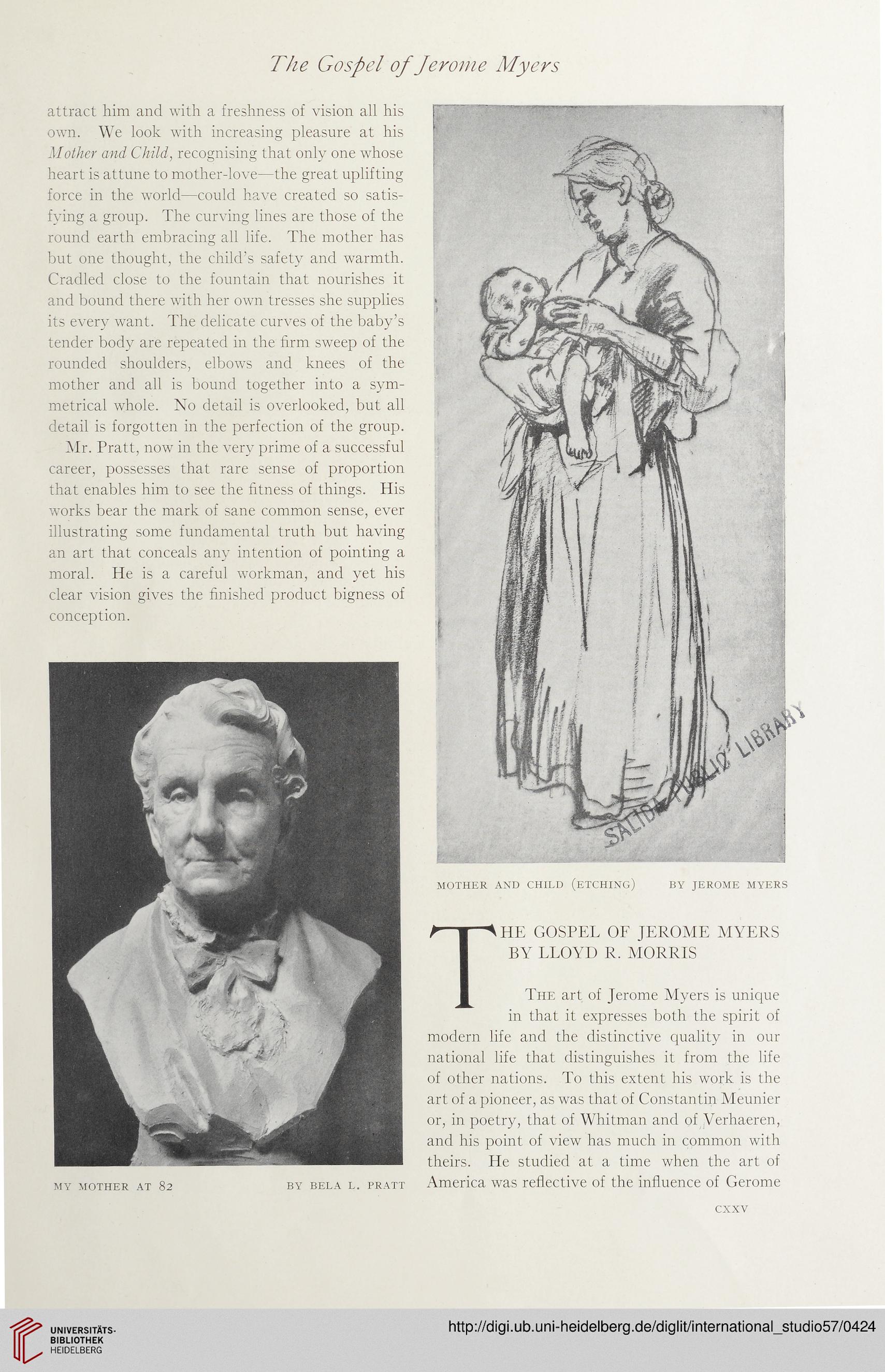The Gospel of Jerome Myers
attract him and with a freshness of vision all his
own. We look with increasing pleasure at his
Mother and Child, recognising that only one whose
heart is attune to mother-love—the great uplifting
force in the world—could have created so satis-
fying a group. The curving lines are those of the
round earth embracing all life. The mother has
but one thought, the child’s safety and warmth.
Cradled close to the fountain that nourishes it
and bound there with her own tresses she supplies
its every want. The delicate curves of the baby’s
tender body are repeated in the firm sweep of the
rounded shoulders, elbows and knees of the
mother and all is bound together into a sym-
metrical whole. No detail is overlooked, but all
detail is forgotten in the perfection of the group.
Mr. Pratt, now in the very prime of a successful
career, possesses that rare sense of proportion
that enables him to see the fitness of things. His
works bear the mark of sane common sense, ever
illustrating some fundamental truth but having
an art that conceals any intention of pointing a
moral. He is a careful workman, and yet his
clear vision gives the finished product bigness of
conception.
MY MOTHER AT 82 BY BELA L. PRATT
MOTHER AND CHILD (ETCHING) BY JEROME MYERS
T
HE GOSPEL OF JEROME MYERS
BY LLOYD R. MORRIS
The art of Jerome Myers is unique
in that it expresses both the spirit of
modern life and the distinctive quality in our
national life that distinguishes it from the life
of other nations. To this extent his work is the
art of a pioneer, as was that of Constantin Meunier
or, in poetry, that of Whitman and of Verhaeren,
and his point of view has much in common with
theirs. He studied at a time when the art of
America was reflective of the influence of Gerome
cxxv
attract him and with a freshness of vision all his
own. We look with increasing pleasure at his
Mother and Child, recognising that only one whose
heart is attune to mother-love—the great uplifting
force in the world—could have created so satis-
fying a group. The curving lines are those of the
round earth embracing all life. The mother has
but one thought, the child’s safety and warmth.
Cradled close to the fountain that nourishes it
and bound there with her own tresses she supplies
its every want. The delicate curves of the baby’s
tender body are repeated in the firm sweep of the
rounded shoulders, elbows and knees of the
mother and all is bound together into a sym-
metrical whole. No detail is overlooked, but all
detail is forgotten in the perfection of the group.
Mr. Pratt, now in the very prime of a successful
career, possesses that rare sense of proportion
that enables him to see the fitness of things. His
works bear the mark of sane common sense, ever
illustrating some fundamental truth but having
an art that conceals any intention of pointing a
moral. He is a careful workman, and yet his
clear vision gives the finished product bigness of
conception.
MY MOTHER AT 82 BY BELA L. PRATT
MOTHER AND CHILD (ETCHING) BY JEROME MYERS
T
HE GOSPEL OF JEROME MYERS
BY LLOYD R. MORRIS
The art of Jerome Myers is unique
in that it expresses both the spirit of
modern life and the distinctive quality in our
national life that distinguishes it from the life
of other nations. To this extent his work is the
art of a pioneer, as was that of Constantin Meunier
or, in poetry, that of Whitman and of Verhaeren,
and his point of view has much in common with
theirs. He studied at a time when the art of
America was reflective of the influence of Gerome
cxxv




